#solina v
Explore tagged Tumblr posts
Text

pinned post :3 :3 :3
honorofthedepths -> themagistersbirthright :3 / dividers are by oomfie, @fatagenda!!

ABOUT hi!! you can call me magpie (he/him). i am an autistic agender trans man. i like and post about medieval history, writing, dragon age, pathfinder, cyberpunk 2077, pillars of eternity, warhammer 40k, and queer stuff (i am not normal about any of these). if you don't like oc posts, you probably won't like a good number of my posts. :3

BLOCKLIST foul creatures with mal intent, wizards who never studied the dark arts and steal from those who did, ghouls who have long left their resting places, and beings that have crawled their way out of the hells. get off my property, or die by my blade.
for the laymen: radfems of all kinds, other bigots, gen AI defenders and users, exclusionists, zionists, transid, radqueers, transmeds, people who think they can reclaim the r slur, etc. you will not be argued with or promoted; i will block you, i will give you no attention. leave me the fuck alone.

DIRECTORY my blog [you are here!] ★ bluesky ★ pillowfort ★ ao3 ★ substack [i try to post here biweekly on thursdays or fridays, if you want to check me out :)]
#pinned post!!#finally finished it LMAO.#did you know this was in my drafts for like. months.#shameful self promotion#<- tag for when i publish something on my substack. shamefully.#magpie vents#<- tag for venting about traumatizing stuff#oc: solina ‘sol’ yiğit von valancius#oc: vincent ‘v’ alter#oc: yveline ‘envy’ surana#<- oc tags! will be adding more
1 note
·
View note
Video
youtube
Arturia Solina V String Machine Synth | My Fave Sounds. The Solina synth sound is so lush.
0 notes
Text
Elgie, Crumar Orchestrator and Sequential Six-Trak
The adorable Elgie returns, this time with a Crumar Orchestrator and Sequential Six-Trak. Submitted by Eston Lathrop via our Facebook page.
The Crumar Orchestrator was released in 1977 and provides an orchestra-in-a-box with Brass, Piano, Clavichord, Cello, and Violin sounds, as well as a Bass sound. They can be combined and each has its own level control. It is particularly good for the Brass and String sounds which are reminiscent of the ARP Solina (we at CatSynth have used the Arturia Solina V on a few recordings).
The Sequential Six-Trak was released in 1984. As a synthesizer, it was a smaller cousin to the Prophet series, but it did include many of the Prophets’ features like cross-modulation. There was also an onboard sequencer six-track sequencer (hence the name) and full MIDI support, including controllers for the various parameters.
var quads_screen_width = document.body.clientWidth; if ( quads_screen_width >= 1140 ) {document.write('<ins class="adsbygoogle" style="display:inline-block;width:600px;height:100px;" data-ad-client="pub-5176416568130778" data-ad-slot="2974773354" >'); (adsbygoogle = window.adsbygoogle || []).push({}); }if ( quads_screen_width >= 1024 && quads_screen_width < 1140 ) {document.write('<ins class="adsbygoogle" style="display:inline-block;width:600px;height:100px;" data-ad-client="pub-5176416568130778" data-ad-slot="2974773354" >'); (adsbygoogle = window.adsbygoogle || []).push({}); }if ( quads_screen_width >= 768 && quads_screen_width < 1024 ) {document.write('<ins class="adsbygoogle" style="display:inline-block;width:600px;height:100px;" data-ad-client="pub-5176416568130778" data-ad-slot="2974773354" >'); (adsbygoogle = window.adsbygoogle || []).push({}); }if ( quads_screen_width < 768 ) {document.write('<ins class="adsbygoogle" style="display:inline-block;width:600px;height:100px;" data-ad-client="pub-5176416568130778" data-ad-slot="2974773354" >'); (adsbygoogle = window.adsbygoogle || []).push({}); }
Elgie, Crumar Orchestrator and Sequential Six-Trak was originally published on CatSynth
1 note
·
View note
Note
Random Ask go! Favorite Pastimes for the problem children of house Benes :V AKA ALL OF THEM! >.>
Celia: Reading fiction
Caius: Drawing/Birdwatching
Cato: Being a spoopy ghostly nuisance and calling Caius out on his nonsense
Solina: Drinking games
Lucius: Reading non-fiction
Theodosia: Playing piano
Caelia: Fencing
#answered#ooc reply#thank you for the ask!#'problem children of House Benes' AKA all of them#don't call me out like this#toxiccreed
3 notes
·
View notes
Text
Interesting Papers for Week 30, 2019
To integrate or not to integrate: Temporal dynamics of hierarchical Bayesian causal inference. Aller, M., & Noppeney, U. (2019). PLOS Biology, 17(4), e3000210.
Inferring neural circuit structure from datasets of heterogeneous tuning curves. Arakaki, T., Barello, G., & Ahmadian, Y. (2019). PLOS Computational Biology, 15(4), e1006816.
Neural population control via deep image synthesis. Bashivan, P., Kar, K., & DiCarlo, J. J. (2019). Science, 364(6439), eaav9436.
Cortical Reorganization of Peripheral Vision Induced by Simulated Central Vision Loss. Chen, N., Shin, K., Millin, R., Song, Y., Kwon, M., & Tjan, B. S. (2019). Journal of Neuroscience, 39(18), 3529–3536.
Contrastive Hebbian learning with random feedback weights. Detorakis, G., Bartley, T., & Neftci, E. (2019). Neural Networks, 114, 1–14.
Vision and Locomotion Shape the Interactions between Neuron Types in Mouse Visual Cortex. Dipoppa, M., Ranson, A., Krumin, M., Pachitariu, M., Carandini, M., & Harris, K. D. (2018). Neuron, 98(3), 602-615.e8.
Two Brains in Action: Joint-Action Coding in the Primate Frontal Cortex. Ferrari-Toniolo, S., Visco-Comandini, F., & Battaglia-Mayer, A. (2019). Journal of Neuroscience, 39(18), 3514–3528.
Novel hybrid action of GABA mediates inhibitory feedback in the mammalian retina. Grove, J. C. R., Hirano, A. A., de los Santos, J., McHugh, C. F., Purohit, S., Field, G. D., … Barnes, S. (2019). PLOS Biology, 17(4), e3000200.
Rich-club connectivity, diverse population coupling, and dynamical activity patterns emerging from local cortical circuits. Gu, Y., Qi, Y., & Gong, P. (2019). PLOS Computational Biology, 15(4), e1006902.
Confidence resets reveal hierarchical adaptive learning in humans. Heilbron, M., & Meyniel, F. (2019). PLOS Computational Biology, 15(4), e1006972.
Microstimulation in a spiking neural network model of the midbrain superior colliculus. Kasap, B., & van Opstal, A. J. (2019). PLOS Computational Biology, 15(4), e1006522.
A Task-Optimized Neural Network Replicates Human Auditory Behavior, Predicts Brain Responses, and Reveals a Cortical Processing Hierarchy. Kell, A. J. E., Yamins, D. L. K., Shook, E. N., Norman-Haignere, S. V., & McDermott, J. H. (2018). Neuron, 98(3), 630-644.e16.
Temporal pattern separation in hippocampal neurons through multiplexed neural codes. Madar, A. D., Ewell, L. A., & Jones, M. V. (2019). PLOS Computational Biology, 15(4), e1006932.
The ease and sureness of a decision: evidence accumulation of conflict and uncertainty. Mandali, A., Weidacker, K., Kim, S.-G., & Voon, V. (2019). Brain, 142(5), 1471–1482.
Learning and forgetting using reinforced Bayesian change detection. Moens, V., & Zénon, A. (2019). PLOS Computational Biology, 15(4), e1006713.
Stability of working memory in continuous attractor networks under the control of short-term plasticity. Seeholzer, A., Deger, M., & Gerstner, W. (2019). PLOS Computational Biology, 15(4), e1006928.
A kinetic model for Brain-Derived Neurotrophic Factor mediated spike timing-dependent LTP. Solinas, S. M. G., Edelmann, E., Leßmann, V., & Migliore, M. (2019). PLOS Computational Biology, 15(4), e1006975.
The Medial Prefrontal Cortex Shapes Dopamine Reward Prediction Errors under State Uncertainty. Starkweather, C. K., Gershman, S. J., & Uchida, N. (2018). Neuron, 98(3), 616-629.e6.
Imperfect Bayesian inference in visual perception. Stengård, E., & van den Berg, R. (2019). PLOS Computational Biology, 15(4), e1006465.
Harmonization of resting-state functional MRI data across multiple imaging sites via the separation of site differences into sampling bias and measurement bias. Yamashita, A., Yahata, N., Itahashi, T., Lisi, G., Yamada, T., Ichikawa, N., … Imamizu, H. (2019). PLOS Biology, 17(4), e3000042.
#science#Neuroscience#computational neuroscience#Brain science#research#neurobiology#machine learning#cognition#cognitive science#psychophysics#scientific publications
2 notes
·
View notes
Text
Fortuna Granda
Arriva il trailer ufficiale del film documentario “Fortuna granda" di Alberto Gottardo e Francesca Sironi, che arriverà nelle sale italiane in tour dal 24 novembre distribuito da Trent Film. Selezionato al Biografilm Festival International Celebration of Lives 2022, il film ha vinto il Premio Solinas per il Miglior Documentario per il Cinema 2020 e racconta la realtà di Goro, un paese in provincia di Ferrara in fondo al Delta del Po che vive grazie alla pesca delle vongole. https://www.youtube.com/watch?v=-HH7XPgqf8Y Fortuna Granda, sinossi Al centro della vicenda Alessandro, Gioele, Matteo e Samuel, quattro ragazzi di 16 anni che pescano in barca da quando ne hanno cinque. «Siamo nati in acqua», dicono in un dialogo del film. Eppure frequentano una scuola che prova a insegnare loro quello stesso mestiere, nel tentativo di tenerli sui banchi, di far loro frequentare gli studi almeno fino al diploma. «Considerate le alternative, perché non si sa mai», dicono i maestri. Ma il confronto non è semplice. Nel film i quattro amici percorrono traiettorie diverse, accomunate dalla consapevolezza del privilegio di un lavoro all’aperto, nella natura, in un territorio altrimenti difficile per i giovani. È nelle contraddizioni di questo desiderio che il film segue i ragazzi fino all’esame di fine anno, con tutti i significati che per ognuno di loro avrà. Le parole dei registi «Fortuna Granda è nato nel 2017»- hanno dichiarato i registi Alberto Gottardo e Francesca Sironi, autori anche del documentario appena arrivato su Mubi “Marghe e Giulia - Crescere in diretta” su una coppia di popolari youtuber - «ci trovavamo nel Delta del Po per un reportage sugli adolescenti della provincia di Ferrara quando siamo arrivati a Goro e abbiamo intravisto i confini di una comunità unica, chiusa sia geograficamente (ci arriva una sola strada), che economicamente (per via della ricchezza delle vongole, arrivata negli anni ‘80). Poco dopo abbiamo scoperto il record di dispersione scolastica del paese. Avanzando su queste domande abbiamo incontrato il corso avviato da Giovanni Lolli, e la classe Pesca dell’Istituto professionale. Alessandro, Gioele, Matteo e Samuel sono diventati subito i protagonisti del film, al primo incontro. Abbiamo iniziato le riprese con il solo desiderio di ascoltarli. Non ci interessava analizzare i ragazzi, studiarli. È piuttosto nell’adesione alla voce dei protagonisti, al loro punto di vista, che abbiamo voluto dare forma al film. Il Delta che abbiamo visto insieme a loro non è paesaggio: è abitudine, muro o gioco. Per questo non abbiamo cercato di estetizzare il contesto naturale. O la scuola, che è complessa, anti-retorica, non ha posizioni facili. Abbiamo lavorato così, costruendo spazi di fiducia, confrontandoci continuamente con l’esperienza, senza precostruzioni. Nel riflettere sulla rappresentazione, durante le riprese e il montaggio, ci sono stati però elementi che non abbiamo mai messo in discussione. Fra questi il dialetto: la possibilità di usare la lingua madre, il Goranto, è stata fin da subito centrale nel nostro rapporto.» Read the full article
0 notes
Text
Arturia Piano and Keyboards Collection 2022.1 CE [WiN] (Premium)
Arturia Piano and Keyboards Collection 2022.1 CE [WiN] (Premium)
Arturia Piano and Keyboards Collection 2022.1 CE [WiN] free Download Latest. It is of Arturia Piano and Keyboards Collection 2022.1 CE [WiN] free download. Arturia Piano and Keyboards Collection 2022.1 CE [WiN] Overview One installer for: B-3 V2 v2.5.1 Clavinet V v1.9.1 Farfisa V v1.9.1 Mellotron V v1.5.1 Piano V2 v2.9.1 Solina V2 v2.9.1 Staqe-73 V2 v2.2.1 VOX Continental V2 v2.9.1 Wurli V2…
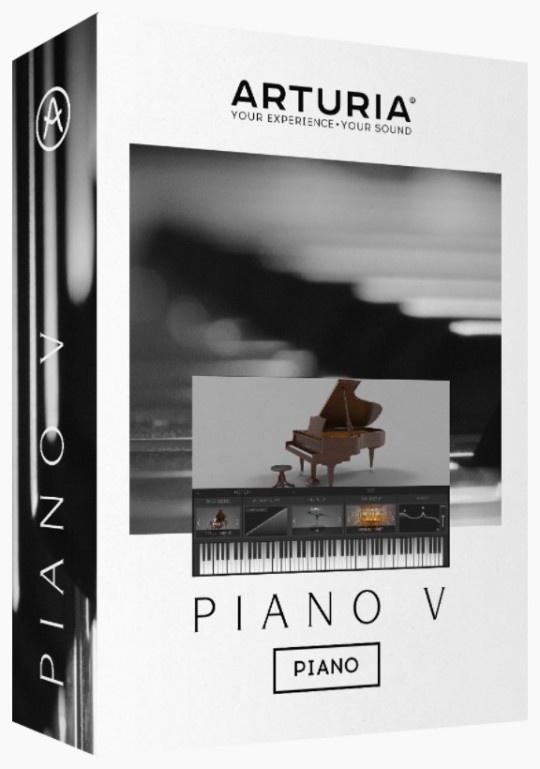
View On WordPress
0 notes
Video
You might hear my daughter in the background there too - Analog Lab Rhodes - this pulls from that 73V rhodes library and uses some killer phaser and amp modeling from the Analog Lab and it works great for an urban old school beat up gooey rhodes @arturia_official does it again. And this is again the Solina V String Machine different sound ..: #arturia #analog #musicforfilm #musicforTV #scoring #wsl #musiclibrary #oldschool #workin
3 notes
·
View notes
Text
Jerome Ramsey plays: Mellotron M400, Expanded Doepfer/Analogue Solutions Modular System, Analogue Systems Modular System, Doepfer MAQ 16/3 Analogue Sequencer, Oberheim OB1, Farfisa Compact Duo, ARP Odyssey, ARP Pro Soloist, ARP Omni 2, Elka Rhapsody 610, Sequential Circuits Pro One, Yamaha SY1, Roland SH101, Roland JD800, Roland 501 Space Echo, Novation Space Station, Fender Bullet Guitar, Behringer V-Amp 2, Chase Bit 99, EMU ESI 4000, JR Electronics Drum Synth, SRS Dual Phaser Unit, Boss Flanger Unit, Kenton Pro 2.
Brendan Pollard plays: Mellotron M400, Bohm Soundlab Modular System, The Beast Duophonic Modular System, SRS RP3 Noise Generator Modular System, Doepfer MAQ 16/3 Analogue Sequencer, Elka Rhapsody 610, ARP Pro DGX, ARP Solina, Logan String Machine, Moog Micromoog, Octave Kitten, Korg Delta, Korg Lambda, Korg MS2000, Roland JP8000, EMU ESI 2000, SRS ZV3 Bass Synth, SRS Philtertron, SRS Dual Phaser Unit, Electro Harmonix Flanger, Melos Echo Chamber, Kenton Pro 2, Philip Rees MCV ×2, JMS CGX Interface, The Space Machine.
This here, kids, is how you can tell you’re about to listen to a Good Synth Album. Not necessary any of the particulars (though some of them are good signs in general) — but, the recognition that synthesizers are not interchangeable, and are often as distinct from each other as a violin is from a cello or an oboe or a steel drum
also: tag yourselves, I’m Arp Solina
#music#synth#synthesizer#electronic music#album is Rogue Element – Premonition (2004)#solina is Finnish for 'sound of running water'
1 note
·
View note
Photo

یک انتخاب حرفهای داشته باش🏅 كفش دخترانه مدل SOLINA سفید قیمت 119 تومان پرداخت درب منزل نحوه سفارش پیامکی 👇 برای خرید کد 7203 را به سامانه 30007419 پیامک کنید جنس رویه : ترکیبی جنس زیره : pu کفی پرسی رنگبندی : سفید سایز : 37 الی 40 برای خرید آسان روی عکس محصول کلیک کنید 🔺 — view on Instagram https://scontent-iad3-1.cdninstagram.com/v/t51.2885-15/99044321_2605569643029356_8634399386308753370_n.jpg?_nc_cat=102&_nc_sid=8ae9d6&_nc_ohc=LMDY3uHOAaQAX_XZSsY&_nc_ht=scontent-iad3-1.cdninstagram.com&oh=3ffdd3a926f3775ad291008981852c64&oe=5EE9A1FB
0 notes
Photo


CALIFICACIÓN PERSONAL: 6 / 10
Título Original: État de siège
Año: 1973
Duración:125 min.
País: Francia
Director: Costa-Gavras
Guion: Franco Solinas, Costa-Gavras
Música: Mikis Theodorakis
Fotografía: Pierre-William Glenn
Reparto: Yves Montand, Renato Salvatori, Jacques Weber, O.E. Hasse, Jean-Luc Bideau, Maurice Teynac, Evangeline Peterson, Jacques Perrin
Productora: Coproducción Francia-Italia-Alemania; Reggane Films / Unidis / Dieter Geissler Filmproduktion
Género: Crime, Drama, Mystery
https://www.imdb.com/title/tt0070959/
TRAILER: https://www.youtube.com/watch?v=zz3E3lgZZjs
0 notes
Audio
DYNAMO // TRACK 11 (Highlands track stories, #8)
A dynamo, from a historical standpoint, was the first machine capable of generating direct current electricity for power and industry. In this, context, it typically consists of an electromagnetic field generated by magnets, through which several coils and windings rotate and produce electric currents. This song was inspired by the motion of such a device; first invented in the mid 19th century, they were powered by steam often times and were rather crude, when you consider how much the invention would eventually contribute to our modern society. The constant motion- the rotation of the coils and all of the moving mechanical parts- serves as the catalyst for the main synth lead in this piece. The constant, four-note arpeggio sweeps down through a single chord and continues through almost the entire track, which is also the longest on the album. After Dreampop, I was somewhat on my way out of experimenting with pitch shifted percussion, at least for the time being, and so in stark contrast from my previous work, this song uses a more traditional electronic drum machine, in combination with a click stick percussion track- a dry, continuous beat which almost resembles the mechanical crackle and pop of moving metal parts. Something like the pistons of an engine. A lot of what inspired the sounds in this track is very inspired by Victorian and early 20th century technology- another prime example is found in the high-pitched "glass shards" sounds which cut through the mix throughout the entire track- these again are an interpretation of a steam engine, the squeaks and whistles associated with engines of the time. This was also the first track on which I really put to use a Solina string synth, to get the dark, somewhat dated sounding string sounds. I don't normally incorporate much orchestral stuff in my music, but it felt appropriate given the music of the time period I was exploring, and as such they stayed in. The main synth is a Prophet V, and the glass shard sounds are produced by a Modular synth. This is one of my favorite tracks I've ever produced, and one of my favorite elements of it is the somewhat unconventional chord structure- it's more of a 2-1-2, one-one arrangement which can be jarring at first, but is something that stuck in my head since I first tried it. The chord is held for two full bars, while the third is held for one, and the last for two again. This song inspired the next few that came after it- in terms of structure and experimentation, this became the focal point for the latter half of the album, and was the hardest track to place in the overall track list. I think as the penultimate track, it does represent a culmination of the ideas on the album, before slowly fading into the final serene and ethereal goodbye of the album with Eagle's Nest.
Notable influences for this track:
Massive Attack - Future Proof
Metamatics - Colmic Zeus
Bonobo - Cirrus
#SoundCloud#music#The Nautilus#Idm#Ambient#Electronic#Soundtrack#dark#chill#trip hop#synth#nautilus#highlands#instrumental#game music#free#soundscape#study#sleep#film score
2 notes
·
View notes
Photo

01. TSUKAMORI Es el tema que elegimos para abrir “Magnolia” por su simbolismo. Es una canción de amor y respeto a la naturaleza por encima de todo. Un bosque quemado del Bierzo donde jugaba de pequeño inspiró la idea de esta canción. “Tsukamori” es el bosque donde vive el espíritu Totoro, en la película de Hayao Miyazaki. Musicalmente, quisimos que la canción se armara desde una base grave de Moog y que el bajo de Miguel tuviera un papel más melódico y agudo durante todo el tema. @doorsmouse quería una batería muy recta y @manuelcabezali propuso muy acertadamente tirarla hacia el krautrock. Para la intro, que además era el principio del disco, buscábamos algo muy significativo y nos inspiramos en los arpegiadores que abren Baba O’Riley de The Who. @martiperarnauiv los fue retorciendo y deconstruyendo a lo largo de toda la canción y consiguió crear esa textura tan característica. Queríamos conseguir intensidad de una manera diferente a la que estábamos acostumbrados y decidimos que las guitarras eléctricas que van armonizando el tema irían totalmente limpias, sólo les añadimos una pequeña reverb corta de muelles. Conseguimos esa intensidad en los puentes y el estribillo final con el Solina Strings y el Juno 6 que me prestó Martí. El único rift distorsionado que entra en el 3:10 rompiendo y desplazando el 4/4 lo grabó Manuel Cabezalí. //Que mis ojos atraviesen la coraza de la tierra enferma Que se abra el manto negro de la noche y libere a las estrellas Que caiga sobre mí la inmensidad Que caiga sobre mí la inmensidad Que el río seco de mi cuello se desborde en los campos del insomnio Y muestre el rastro del camino invisible que me lleve hacia ti Que pueda oír tu voz y recordar Que pueda oír tu voz y recordar Que el bosque muerto despierte Que el aullido del viento se haga canción Que levante las hojas y bailen Que la rama me encuentre en la oscuridad Que su túnica verde me abrace Que el bosque muerto despierte// V https://www.instagram.com/p/BvB4Lz3B6EC/?utm_source=ig_tumblr_share&igshid=utui36sg3fxo
1 note
·
View note
Text
Eine weitere Sammlung analoger Klassiker - 12 Synthesizer Plugins von Electrostudio für umsonst ... plus 5 spezielle Freeware Lieblinge.
Ja ja, ok. Das Analog Pack des polnischen Entwicklers, dessen Namen ich nichtmal in Erfahrung bringen konnte - ich nenne ihn im folgenden einfach mal Electrostudio - ist alt. Verdammt alt. Genau genommen ist das letzte Update der Website von 2012. Alle Plugins sind in 32Bit und werden nicht mehr aktualisiert. Aber hey, die Teile klingen echt gut, machen Spaß, sehen super aus und sind absolut umsonst. Also “Hut ab” vor dem Entwickler hinter Electrostudio!
Warum komme ich jetzt 5 Jahre später mit einem Beitrag dazu? zum einen hatte ich hier vor kurzem etwas zu der Synth Sammlung von Arturia gepostet. Diese Sammlung ist nicht gerade billig und ich wollte mal sehen, was es so im Freeware Bereich gibt. Allerdings ist der Markt riesig und ich wollte wirklich nicht alle vorhandenen Freeware Plugins testen. Falls jemand interessiert ist an eine Übersicht wirklich guter Freeware Plugins, empfehle ich die Seiten des Bedroom Producer Blogs.
Aber ich habe mich an diese Sammlung erinnert und das passte so gut. Ich mag nahezu alle Plugins dieser Serie, sie emulieren ebenfalls alte Klassiker (und teilweise sogar richtig skurrile Teile) und tja, sie sind nunmal umsonst.
Insgesamt umfasst die Sammlung 10 Synthesizer, die im Analog Pack zusammengefasst sind und in einer Zip-Datei heruntergeladen werden können. dieser Download ist gerade mal knapp 29MB groß. Dann habe ich noch die beiden extra Synthesizer von Electrostudio dazu genommen, den Minimoog und den Moog Prodigy, somit umfasst die Electrostudio Sammlung 12 Instrumente, die kaum Platz auf der Festplatte beanspruchen.
Da in der Arturia V Collection auch Orgeln, ein Piano und zwei elektrische Pianos vorhanden sind, habe ich noch zusätzlich im Anschluß meine 5 Lieblingsinstrumente aus dem Freeware-Bereich aufgezählt. Ein Piano, eine Orgel, ein Wurlitzer und zwei 8Bit Spielereien.
Dies hier ist keine “Best of Freeware” Scheiße. Dazu gibt es schon genug Seiten und Diskussionen im Netz. Dies sind einfach Freeware Plugins, die mir persönlich gefallen und die ich für meine Projekte benutze. Teilweise weiß ich nichtmal wie die Originale dieser Emulationen klingen, und es ist mir auch egal. Ich mag genau diese Plugins. Weil ich vor ein paar Tagen die großartige V Collection vorgestellt habe, wollte ich so etwas ähnliches nun im Freeware Bereich machen, denn man kann auch Plugins benutzen, die gar nichts kosten und trotzdem gut klingen. Nochmal “Hut ab” an die Entwickler, die diese Software umsonst zur Verfügung stellen.
Davolisint
Athos Davoli hatte eine italienische Firma in den 60ern und 70ern, die Verstärker, Boxen und sonstiges Gitarrenzubehör gebaut und verkauft hat. Später kamen dann auch noch einige obskure Orgeln dazu. Dazu hat Davoli ungefähr sieben Keyboards und Synthesizer entworfen und gebaut. Teilweise existieren davon aber nur Prototypen. Der erste, aus dem Jahre 1972 - war der Davolisint.
1972 war eine Zeit, in der der Synthesizer-Boom noch nicht so wirklich begonnen hat. Es gab zwar schon den Arp 2600 und den Minimoog, aber die etwas günstigeren Modelle von Roland oder Yamaha kamen erst ungefähr ein Jahr später. Der Davolisint war der erste italienische Synthesizer und wahrscheinlich auch der erste europäische.
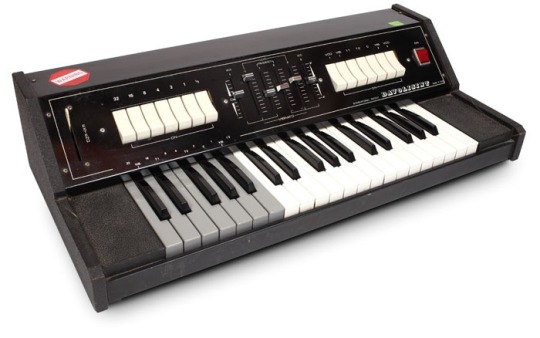
(Quelle: soundonsound.com)
Der Synthesizer funktioniert so ähnlich wie eine Transistororgel. Im Kern besitzt er zwei Oszillatoren, aber keine Envelopes oder LFOs, wie man es von anderen Synths so kennt. Man kann nicht mal eine Waveform für die Oszillatoren einstellen. Man hat nur sieben Schalter, die jeweils eine Oktave dazu schalten. Die Oszillatoren schwingen in einer rechteckähnlichen Form und man hat somit die Möglichkeiten 7 Oktaven dieser Rechteckwellen übereinander zu legen.
Ansonsten gibt es noch einige Regler in der Mitte, die die Tonhöhe der OSCs regeln und Vibrato dazu schalten können. Das muss reichen. Trotzdem macht es unheimlich Spaß mit dem spartanischen Synth herumzuspielen, denn Electrostudio hat mit dem DavoSynth ein nettes Ebenbild erschaffen. Außerdem wurde noch ein Chorus und Delay Effekt dazugepackt.
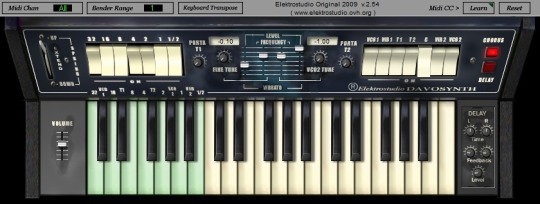
Arp Solina String Ensemble
Eine String Machine darf auch hier natürlich nicht fehlen. Electrostudio hat sich hier mehr oder weniger an die Solina von Arp gehalten.

(Quelle: synthpalace.com)
Die Solina war in einem wunderbaren Holzfunier erhältlich und kostete in den 70er Jahren ca. 2.500 Mark. Die eSLine von Electrostudio ist eine schöne Nachbildung der cheesy Streicherklänge und kostet rein gar nichts.

Moog Micromoog
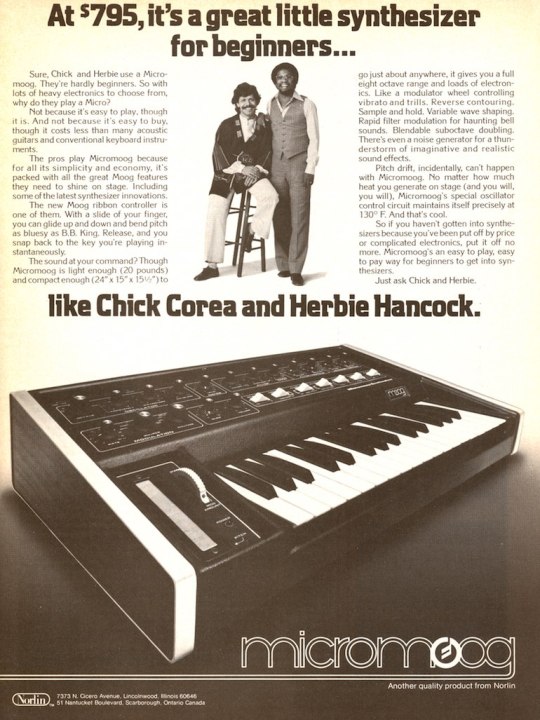
(Quelle: http://retrosynthads.blogspot.de)
“Für 795 Dollar ist es ein großartiger Synthesizer für Anfänger”, so hieß es in einer Anzeige aus dem Jahre 1975. Der Micromoog war quasi der kleine Bruder des Minimoog für jedermann. Dieser Monosynth verfügte über einen Oszillator, einen Amp Envelope, einen Filter und einen LFO. Ein guter Synthesizer um sich mit den Grundlagen der Synthese vertraut zu machen.
Electrostudio hat ihren Micromoon noch eine Effektsektion spendiert. Außerdem kann man den Micromoon auch polyphon schalten. Es macht wirklich Spaß mit diesem einfachen Synth zu spielen.
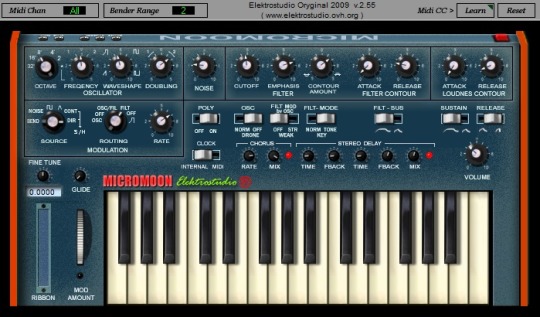
Moog Minimoog
Der Vorzeigesynthesizer aus dem Hause Moog. Ich habe ja vor kurzem im Artikel übers Arturia V Collection schon einiges dazu geschrieben. Electrostudio hat den Minimoog liebevoll Model Mini getauft. Ansonsten wurde sich ziemlich genau am Original gehalten.
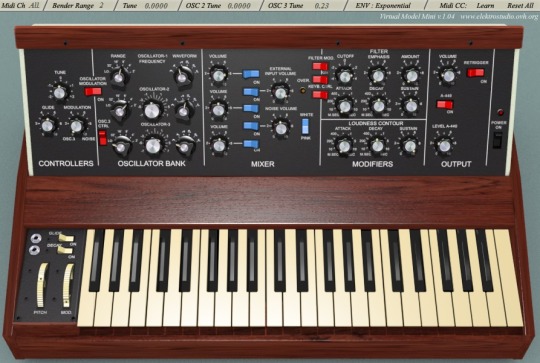
Moog Sonic Six
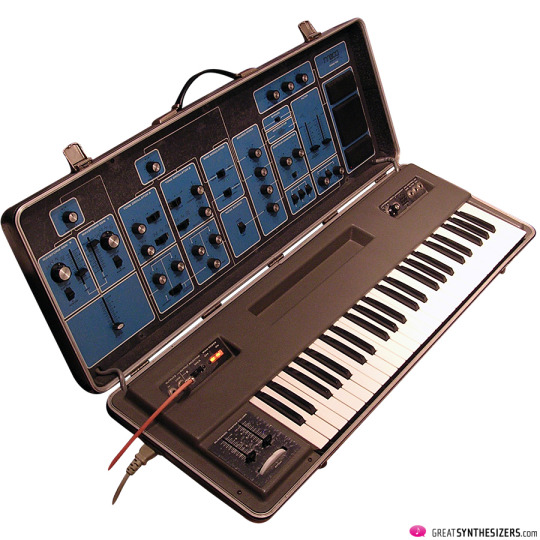
(Quelle: greatsynthesizers.com)
Anfang der 70er war keine allzu gute Zeit für die Firma Moog. Die Welle des Erfolges ebbte immer mehr ab, denn keiner wollte weiterhin mit den Ungetümen der Modular Reihe hantieren. Man wünschte sich kleinere, transportable Systeme. Aber Bob Moog wollte zunächst von all dem nichts hören, bis seine Firma das Aus drohte.
So entstand der Sonic Six, ein tragbares System, dass ebenfalls als Lehrsynthesizer konzipiert war. Mochte Moog anfangs den Gedanken an tragbaren Systemen überhaupt nicht, wurde der Sonic Six später sein Lieblingssynth, den er auf Präsentationstouren immer dabei hatte. Er wurde von 1972 bis 1979 gebaut. Nach dem Sonic Six wurde vermehrt an tragbaren Systemen gearbeitet und so entstand etwas später der berühmteste aller Monosynths, der Minmoog Model D.
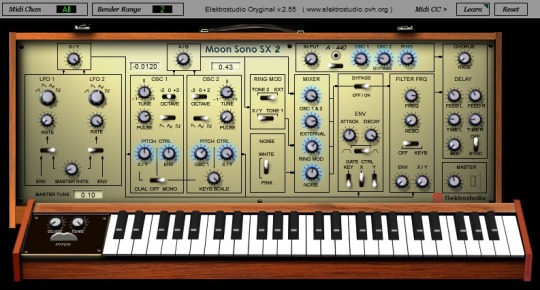
Die Version von Electrostudio mit dem Namen Mono Sono SX 2 sieht etwas anders aus, zumindest farblich. Von den Einstellungsmöglichkeiten und dem technischen Aufbau wurde sich weitgehend am Original orientiert.
EKO ComputeRythm
Ich mag alte Drum Machines. Besonders wenn sie schön lofi klingen. Ich bin ein großer Fan der CR-78 und die EKO ComputeRhythm kannte ich bis vor kurzem gar nicht. Sie stammt aus Italien und wurde 1972 veröffentlicht.
youtube
Die ComputRhythm ist verdammt rar. Es soll wohl nur 20 Stück weltweit geben und vor kurzem hat jemand sein Sammlerstück für 15.000 Dollar verkauft. Jean-Michel Jarre hat sie wohl des öfteren für Aufnahmen eingesetzt und ansonsten gibt es nicht allzu viel Informationen im Netz.
Naja, zumindest hat Electrostudio diese Rarität nachgebaut, in einem VST Plugin namens Ocet Rhythmsynth. Ich habe mich sofort in die kleine Drum Machine verliebt.
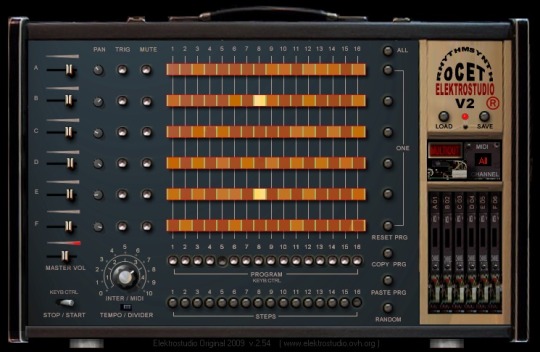
Sie bieten 6 Spuren und dementsprechend auch 6 Instrumente, die sich über die Tasten C1 bis F1 der Miditastatur spielen lassen. D.h. man könnte einfach die schnuckeligen Samples benutzen und den Midi-Editor der DAW zum programmieren nehmen. Oder man fummelt mit dem 6 Spur Sequenzer der Ocet herum. Hier hat man nicht allzu viele Möglichkeiten, aber es macht Spaß damit einen Beat zu programmieren.
Rechts kann man dann noch in die Platine klicken und kann somit an jedem Drumsound so einiges verstellen: Tonhöhe, Tone Decay, Pitch Decay, dann gibt es noch einen Filter und Noise Generator. Außerdem besteht noch die Möglichkeit per Knopfdruck alle Werte zufällig zu verstellen und so alle möglichen Sounds pro Drum zu generieren. Leider lassen sich diese Parameter in der DAW nicht automatisieren :( Trotzdem, danke für diese nette Drum Machine!
Arp Odyssey
Logischerweise musste Arp auf die tragbaren Systeme, wie dem Minimoog von Moog antworten. Und so entstand dann der Odyssey 1972 (irgendwie wurden verdammt viele große Synth-Legenden 1972 gebaut). Der Odyssey ist ebenfalls eine Synth-Legende und bis heute der meistverkaufte Synthesizer von Arp.
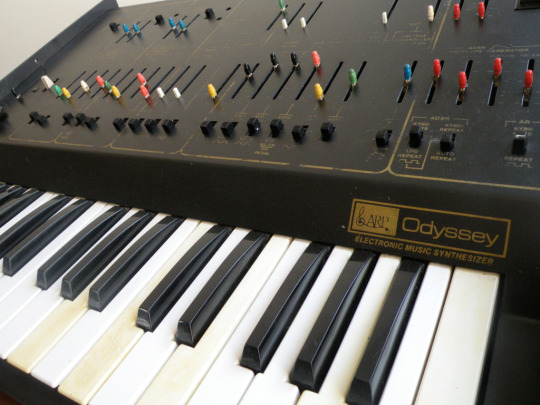
(Quelle: vintagesynth.com)
Im Grunde ist der Odyssey eine festverdrahtete, kleine Version des Arp 2600, kompakter und günstiger. Zwei Oszillatoren, Filter, Envelopes … das übliche. Electrostudio hat seinem Odsay noch ein Echo spendiert. Man kann ihn, genau wie das Original, monophon oder duophon spielen.
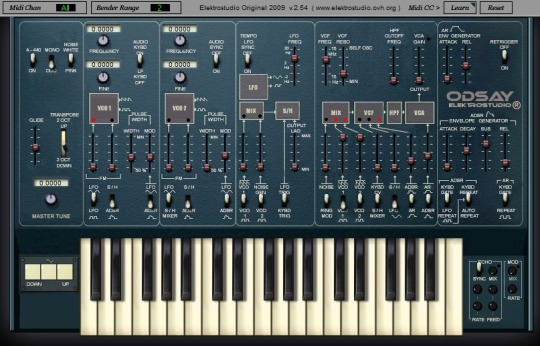
Oberheim Two-Voice
Der Two-Voice war 1975 Oberheim’s Antwort auf die steigende Nachfrage nach polyphonen Synthesizern. Tom Oberheim schloß einfach zwei seiner SEMs zusammen, verbaute alles in einem kompakten Gehäuse mit Tastatur … fertig.
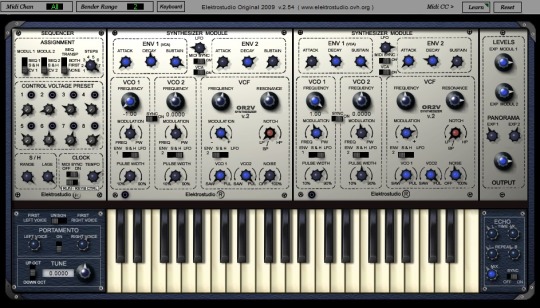
Natürlich ist diese Synth auch in der Sammlung von Electrostudio.
Korg Mini Pops 7
Oh ja, wieder eine Drum Machine ganz nach meinem Geschmack. Die Korg Mini Pops 7!
youtube
Die Mini Pops Serie von Korg enthielt so einige Drum Machines, die zwischen den späten 60ern und den späten 70ern gebaut wurden. Sie verfügten alle über feste Rhythmen, die man über Druckknöpfe abrufen konnte. Sie waren als Begleiter zum Üben oder für Alleinunterhalter gedacht aber ihr spezieller Sound landete dann auch auf vielen Pop Platten. Besonders Jean-Michel Jarre, der auch schon ein Fan der EKO ComputeRhythm war, setzte sie für einige Aufnahmen ein. Interessant war, dass man mehrere Rhythmen gleichzeitig abspielen konnte, indem man einfach mehrere der Knöpfe eindrückte. Das war zwar vom Hersteller nicht so gedacht, lieferte aber interessante Rhythmen.
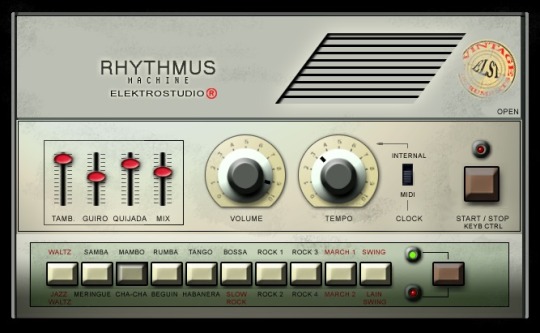
Die Electrostudio Version ist ein schöner Nachbau, der den Sound der Bassdrum noch etwas fetter liefert. Man kann natürlich das Tempo einstellen und die Lautstärke. Sie bietet insgesamt 20 Rhythmen, weil alle Schalter doppelt belegt sind und auch hier kann man mehrere Rhythmen übereinander legen. Genau wie auch bei der Original Mini Pops 7 sind hier auch noch 3 Percussion Elemente (Tamborine, Guiro und Quijada) enthalten, die individuell mit in den jeweiligen Rhythmus gemixt werden können.
Über den kleinen “Open” Taster kann man auch hier das Gehäuse öffnen und ein paar kleine Änderungen am Sound der einzelnen Elemente vornehmen (Tone, Volume und Pan). Wenn man die Rhythmen nicht mag, lassen sich auch nur die Samples nutzen, denn per Midi-Keyboard sind diese ebenfalls spielbar. Das GUI macht wie bei den meisten der Electrostudio Plugins hier auch eine sehr gute Figur.
Roland Juno-6
Der Juno-6 war der erste der durchaus erfolgreichen Juno-Serie von Roland. Er erblickte 1982 das Licht der Welt und war ein 6-stimmiger, polyphoner Synthesizer. Sein Manko war, dass er nicht programmiert werden konnte. Deshalb schob Roland später schnell den Juno-60 nach.
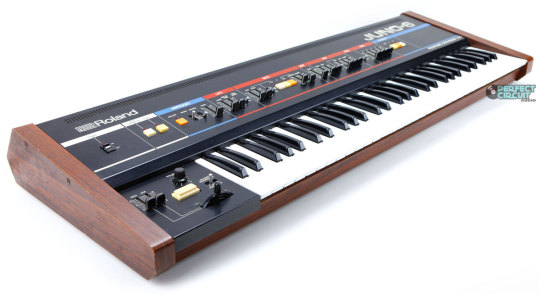
(Quelle: vintagesynth.com)
Der Juno-6 war relativ einfach aufgebaut, aber für seinen Klang sehr beliebt. Er verfügte über eine Oszillator, einen Arpeggiator, Chorus und Delay. Die Electrostudio Version hat den zauberhaften Namen “Sixth Month June” und klingt vielleicht nicht ganz so wie das Original, aber dennoch gut einsetzbar.
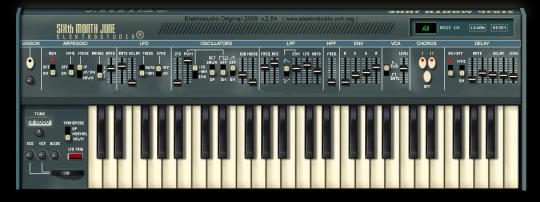
Ein Mellotron!
Ich mag das Mellotron. Das Mellotron ist wohl der erste Sampler überhaupt und der berühmteste Einsatz war sicherlich 1967 von den Beatles “Strawberry Fields Forever”. Das Flöten-Intro wurde von Mr Lennon auf einem Mellotron gespielt.
youtube
Wie gesagt, ist das Mellotron der wahrscheinlich erste Sampler. Die Technik ist im Grunde total naiv. Ich glaube als 8-Jähriger habe ich selber schon darüber nachgedacht ein Keyboard zu bauen, dass pro Taste Sounds von einer Cassette abspielt, und ich habe vorher noch nie von einem Mellotron gehört. Naja, ich war 8 und hatte natürlich absolut keine Ahnung, wie man so etwas verwirklicht.
Ist ja auch egal, denn Harry Chamberlin wusste in den 50er Jahren des letzten Jahrhunderts schon, wie man so etwas anstellt. Die Firma Streetly Electronics übernahm später diese Idee und veröffentlichte 1963 das erste Mellotron, welches über 35 Tasten verfügte, die individuelle Tonbänder mit Sounds abspielten.
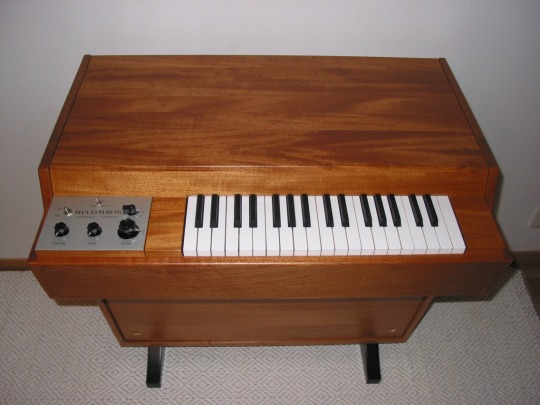
(Quelle: mellotron.com)
Noch heute gibt es die Firma, aber sie stellt keine Instrumente mehr her, sondern wartet und repariert nur noch die alten, beliebten Mellotrons.
Die Mellotrons waren schwer und störanfällig, weshalb sie selten den Weg auf eine Bühne fanden. Trotzdem waren sie beliebte Instrumente, besonders in den 70er Jahren. Später wurde ihre Sounds dann durch digitale Klänge ersetzt. Charakteristisch war ihr melancholischer Klang und durch die Abnutzung der Magnetbänder kam mit der Zeit auch das charakteristisches Leiern dazu.
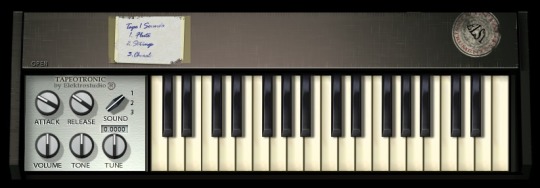
Electrostudio hat eine nette und einfache Software-Version gebaut, die drei Sounds beinhaltet (Flöten, Streicher und einen Chor). Das sind eigentlich die wichtigsten und meistens eingesetzen Mellotron-Sounds und das TapeOTronic klingt richtig gut. Es gibt Standardeinstellungen, wie Attack und Release, Lautstärke und Tone, außerdem kann man die Stimmung noch verändern.
Wenn man das Gehäuse des Plugins aufklappt, sieht man die Bänder rotieren und wenn man rechts auf das Rad mit der Maus klickt, kann man es schneller oder langsamer drehen lassen. Diesen Effekt kann natürlich auch das Pitchwheel des Midi-Keyboards übernehmen. Alles in allem ein sehr schönes, einfaches Plugin, dass hier des öfteren mal zum Einsatz kommt.
Moog Prodigy
Ein weiterer Monophoner von Moog, der 1980 bis 1984 produziert wurde. insgesamt wurden ungefähr 11.000 Stück davon unter die Leute gebracht. Obwohl zu dem Zeitpunkt die große Zeit der monophonen Synthesizer vorbei schien, erreichte der Prodigy fast den gleichen Erfolg, wie der bekannteste Moog Synth, der Minimoog.
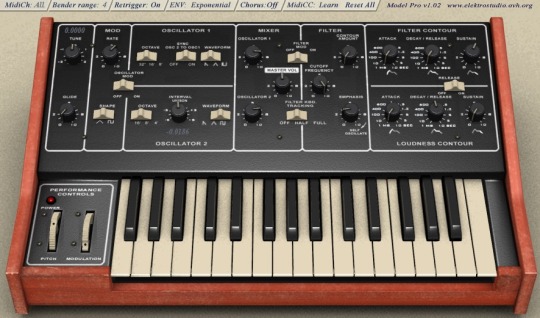
Aus diesem Grund hat Electrostudio auch dem Prodigy die Ehre erwiesen und mit dem Model Pro ein schönes Plugin programmiert. Das GUI sieht fantastisch aus es macht Spaß auf dem Synth zu spielen.
Fazit
Wie bereits eingangs erwähnt, ist diese Serie alt und wird nicht weiterentwickelt. Es gibt sie nur als 32Bit Plugins, was für einige Nutzer ein Problem sein könnte und sie sind nur für Windows verfügbar. Aber ich finde diese Sammlung bemerkenswert. Der polnische Entwickler hat viel Arbeit in die Entwicklung gesteckt und hatte eigentich vor, diese kommerziell zu vertreiben. Nach etlichen Streitereien und diversen Problemen hat er sie kurzerhand frei verfügbar gemacht.
Und auch wenn sie alt sind, finde ich trotzdem, dass man sie sehr gut einsetzen kann und sie ihren Platz in allen möglichen Aufnahmen finden können. Denn sie sind absolut kostenlos. Ich hatte bei der Installation erst ein paar Probleme. Man sollte die Plugins nicht in den Standardordner für VST-Plugins kopieren, weil sie schreibenden Zugriff auf diesen Ordner brauchen, um Sachen zu speichern. Die neueren Windows Versionen erlauben aber nicht so ohne weiteres den Zugriff auf Ordner innerhalb der “Programme” Struktur. Um irgendwelchen stressigen Einstellungen aus dem Weg zu gehen, würde ich empfehlen die Plugins innerhalb von “Dokumente” zu speichern oder in einem anderen Bereich der Benutzer-Ebene.
Da die Plugins in 32Bit geschrieben sind und die meisten Nutzer heutzutage 64Bit DAWs einsetzen, könnte es sein, dass man eine 32Bit Bridge benötigt, wie z.B. jBridge. Manche DAWs unterstützen aber auch von Haus aus 32Bit Plugins, wie z.B. Bitwig oder Renoise.
Also, herunterladen, installieren und ausprobieren. Macht Spaß, tut nicht weh und kostet nichts.
Zugabe, Zugabe …. !!!
Ich will an dieser Stelle nicht alle möglichen Freeware Plugins aufzählen, die mir besonders gut gefallen, dass würde wohl ewig dauern. Allerdings will ich noch fünf Plugins dazu nehmen, die ebenfalls umsonst sind und die Synthesizer Sammlung ganz gut abrunden. Angelehnt an die Arturia Sammlung fehlt hier auf jeden Fall ein Piano, eine Orgel und ein elektrisches Piano (auch wenn das keine Synthesizer im eigentlichen Sinn sind). Dazu noch ein paar 8Bit Spielereien aus meiner Kindheit :)
DirtBag
Eine Orgel mit viel Schmutz. Das GUI sieht etwas gewöhnungsbedürftig aus, aber es gibt viel zum Einstellen und Sound verbiegen. Man kann sogar Sounds aus ihr herauskitzeln, die nur noch ganz entfernt an eine Orgel erinnern.
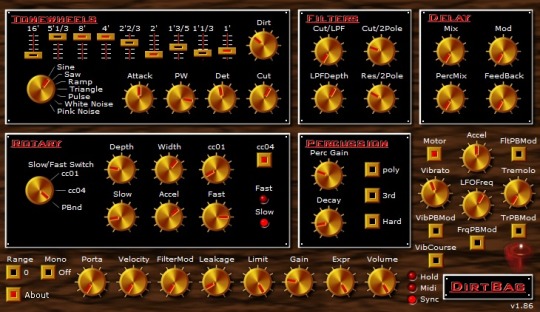
DirtBag ist ebenfalls ein 32Bit Plugin, das von Istvan Kaldor stammt. Ich glaube das Plugin ist auch schon uralt, kann aber nicht genau sagen, wann die aktuelle Version veröffentlicht wurde. Ist ja auch egal, ich mag den Klang und das Plugin funktioniert.
City Piano
Dieses PIano ist im Download etwas größer, weil es eine Sample-Library beherbergt, die die einzelnen Nuancen des Pianos in etwas über 400MB Samples verpackt hat. Das GUI ist gräßlich, aber der Klang ist super.

Aber hey, es ist ein Piano. Da muss man nicht viel mit dem GUI herumspielen. Man kann zwar noch einiges einstellen, Attack, Decay, Sustain und Release, außerdem Volume und Pan … muss man aber gar nicht.
Das Plugin stammt von BigCat Instruments und ist natürlich ebenfalls kostenlos. Der Download dauert vielleicht einen Moment länger, weil halt sehr viele Samples vorhanden sind. Das aufgenommene Piano ist ein Baby Grand, welches ein wenig den Raum mit einfängt, in dem es recorded wurde. Ich mag den einfachen Klang. Es ist relativ lofi so wie es ist. Es erinnert mich ein wenig an die Beatles und den Klang der Abbey Road Studios, vielleicht gefällt es mir deshalb so gut. Einen guten Reverb-Effekt hinten dran .. super!
Big Cat Instruments hat so einiges an VSTs und Kontakt Libraries veröffentlicht, aber ich habe mir nicht wirklich alle durchgehört. Das City Piano gibt es übrigens auch als Kontakt Library. Ansonsten war mein Lieblingspiano immer das Gentleman Upright der Komplete Kontakt Libraries. Es ist natürlich immer ärgerlich, wenn man irgendwann mal Geld für Sachen ausgegeben hat und etwas später dann etwas entdeckt. dass nichts kostet und einem fast besser gefällt. Aber so ist es nunmal. Danke an BigCat Instruments.
MrTramp 2 - Wurlitzer Electric Piano
MrTramp 2 ist ein Physical Modeling Plugin, dass ein Wurlitzer 200a Electric Piano simuliert. Es ist klein, total einfach zu bedienen und klingt super. Es könnte vielleicht etwas mehr Biss haben, aber wenn man einen Overdrive Effekt dezent hinten anhängt ist alles ganz fantastisch. Einziger Nachteil ist das Tremolo, das klingt zwar gut, die Frequenz lässt sich aber nicht verändern. Also sollte man hier auch besser einen Tremolo Effekt der DAW benutzen.
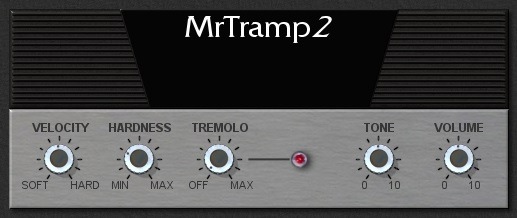
Ein paar Sachen zum Einstellen gibt es auch: Velocity, Härte der Hämmer, Tremolo (hmmm… nur feste 6Hz Triangle), dann Tonhöhe und Lautstärke. Alles ganz selbsterklärend. Ich mag dies Wurlitzer gerne, Tremolo dahinter, dann etwas Distortion und ein schönes Reverb … perfekt!
Commodore C64
Kennt den noch jemand? Ich hatte den früher in meiner Kindheit. Da gab es noch keine Playstations oder XBoxen. geschweige denn PCs. Der C64 war wohl der berühmteste Heimcomputer der 80er Jahre. Auch wenn er überwiegend zum Spielen benutzt wurde, konnte man ihn auch in Basic programmieren.
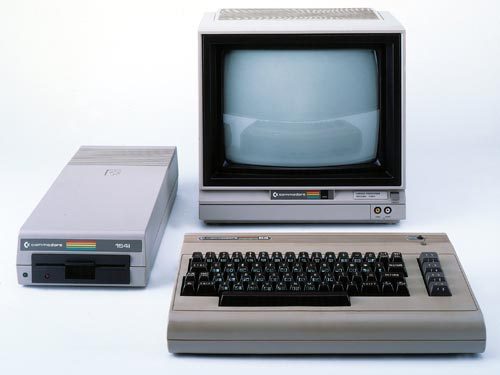
Der C64 hatte einen ganz speziellen Soundchip, den SID, der auch in andere 8Bit Computer von Commodore verbaut wurde. Der Sound dieses Chips ist legendär und immer noch total angesagt. Ich mag diesen Sound und nutze das Basic64 VST Plugin dafür.
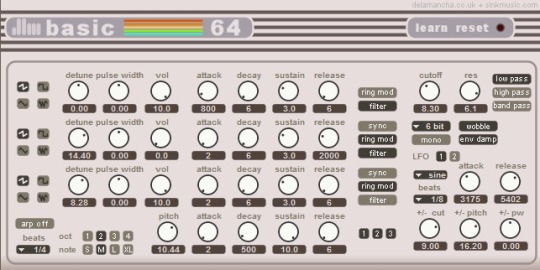
Es verfügt über 3 Oszilatoren und typische Synthesizer Einstellmöglichkeiten. Man kann dem Teil echt schräge Klänge entlocken.
Text To Speek
Wieder eine nette 8Bit Spielrei. Für den C64 gab es damals so eine Basic-Erweiterung namens SAM, welche geschriebene Worte in Sprachausgabe umwandelte. Das klang natürlich alles herrlich nach bescheuerten Robotern. Es gibt auch ein VST Plugin, dass diese Technik ganz hervorragend emuliert. Das VST Speek 3.
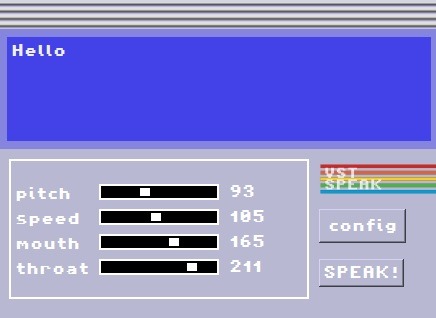
Man gibt seinen Text ein und die Roboterstimme gibt sie wieder. Natürlich kann man diese Phrasen dann auch mit der Midi-Tastatur spielen. Also, quasi wie ein textbasierter Sampler. Da fällt mir sofort wieder Radiohead ein.
youtube
Man hat noch so einiges an Einstellmöglichkeiten, um die Stimme etwas anzupassen. Das berühmte “Exterminate!” der Daleks bekommt man dann damit auch ganz gut hin :D
youtube
#Freeware#Plugins#VST#Synthesizer#Electrostudio#DAW#Homerecording#VSTi#Klavier#Sampler#Samples#Synth#umsonst#frei#C64#8Bit#Noise
1 note
·
View note
Link
Gracias a Concursos Literarios - Escritores.org
0 notes
Text
Piove di Paolo Strippoli
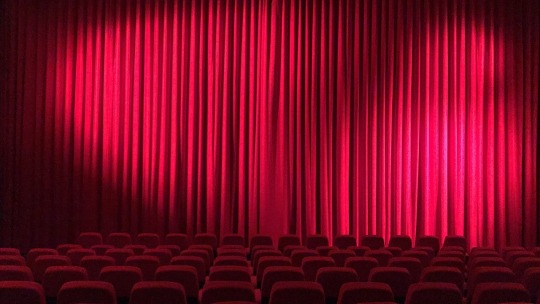
Dopo aver vinto il premio per la Miglior Regia al Festival di Taormina 2021, con il film d’esordio A Classic Horror Story, Paolo Strippoli torna con Piove, un dramma-horror ambientato in una Roma costantemente sul punto di esplodere. https://www.youtube.com/watch?v=8QmrmU3QDtA&feature=youtu.be Il film nasce dalla scrittura di Jacopo Del Giudice vincitore con Piove della 32° edizione del Premio Franco Solinas. Da qualche giorno Roma è teatro di un evento singolare: quando piove condotti e tombini tracimano con una melma grigiastra ed esalano un vapore denso di cui non si conosce l’origine. Nessuno può immaginare che chiunque respiri questo misterioso vapore dovrà farà i conti con ciò che reprime, i suoi istinti più oscuri, la sua rabbia. Neanche la famiglia Morel. Read the full article
0 notes